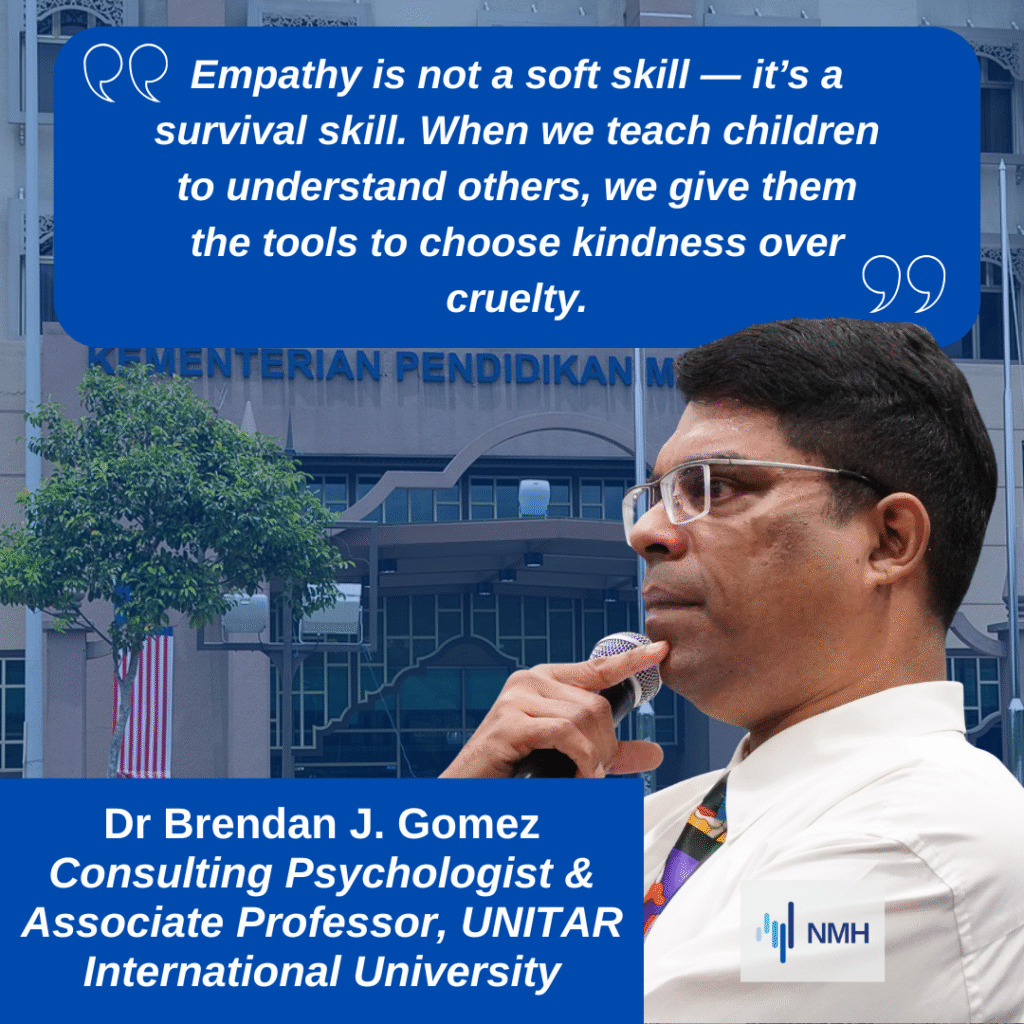In Part 1 of this series, we confronted the horror, heartbreak, and public outrage following the recent cases of violence and school bullying here in Malaysia. In Part 2, we look beyond the grief — at the conversations, workshops, and quiet courage of teachers and parents trying to heal a wounded system. From the UNITAR–JPN mental-health session to real stories from classrooms and homes, this is where empathy meets action.
When Empathy Becomes More Than a Word
In the aftermath of the school bullying incidents that shook the nation — the brutal gang rape in Melaka, the killing in Bandar Utama, and the stabbing of a schoolchild by her classmate — Malaysia’s grief and anger are still raw. But grief alone isn’t enough.
The scale of the crisis cannot be overlooked. According to the Education Ministry’s Student Discipline System, reported bullying cases jumped from 3,883 in 2022 to 6,528 in 2023, and then to 7,681 in 2024 — a rise of over 17 per cent.
According to the Trends in International Mathematics and Science Study (TIMSS) 2023, Malaysia ranks among the top four countries worldwide where students report being bullied at school. The study, which surveys both academic performance and student wellbeing, highlights how pervasive bullying has become — extending far beyond isolated cases and into the daily lives of children nationwide.
A Movement Rooted in Empathy
At the recent Mental Health Awareness Session organised by UNITAR International University in partnership with the Jabatan Pendidikan Negeri (JPN), more than 120 educators gathered not merely to talk about problems but to rediscover the human pulse behind education — the “HEART” model championed by Dr Brendan J. Gomez: Honed Observations, Established Psychological Safety, Acting with Compassion, Rallying the Community, and Tending to One’s Own Wellbeing.
Dr Gomez’s approach focuses on one deceptively simple but transformative goal: teaching empathy as a life skill.

“Until we walk in the shoes of another, we find it hard to truly understand how someone is feeling — especially when they are hurting or struggling with a life challenge,” he said.
Through storytelling, drawing, and even dancing, teachers learned to re-humanise their classrooms — to listen actively, to see beyond grades, and to notice the child who grows quieter each day.
“Empathy is a key part of Social Emotional Learning (SEL),” Dr Gomez explained, “and it’s critical for young people to master — to help them cope better with mental-health issues and in building resilience.”
For many of the counsellors present, it was the first time they had space to reflect, to speak openly, and to connect their exhaustion with purpose.
When Teachers Are Left to Heal Alone
Among the participants was a teacher from a government school in Kuala Lumpur — a Sabahan who carries two invisible scars. One of her students once took her own life, jumping from a nearby flat. Days earlier, the teacher had spoken to the girl, who said her stepfather had struck her. The man, who had raised her since she was three, insisted it was a single act of discipline, not cruelty.
A few days later, tragedy struck.
The teacher later stopped another student from taking the same path — this time saving a life. Yet when asked whether the Education Department had sent her for counselling after such trauma, her answer was painfully simple:
“No. They just wanted my report.”
The silence that follows such tragedies isn’t just administrative — it’s moral. It mirrors a system where teachers are expected to absorb every shock, yet given no outlet to heal.
When Parents Speak, the Nation Must Listen
For parents like Mazuin Murtadza, the tragedy of school violence hits painfully close.
“I am still shocked that Ayman knows what kerambit is,” she said, referring to one of the weapons allegedly used by the 17-year-old boy accused of murdering his schoolmate. “Ayman is only 10 years old, and in their Roblox world, they need Robux to buy such virtual weapons. Of course I am to blame — I allowed him to play, even gave money to buy Robux,” she confessed, her voice trembling with guilt.

Her unease runs deeper than the game. Ayman had been bullied two years earlier — “a girl used to call him stupid, ugly and dumb; she stole his pencils and erasers” — but he was fortunate to have classmates who defended him.
“The one who stood up for him was the smallest kid of them all,” she said, half-smiling through the ache.
Mazuin’s hope is simple yet profound:
“It will be a safe place if all kids would snitch and not just be bystanders. Protect each other when they see something not right. See and hear.”
Anne Subashini: Turning School Bullying Outrage into Outreach
For Anne Subashini, founder of the Inclusive Outdoor Classroom (IOC) and mother of two, the recent spate of violence has reignited an old fight — to bring inclusion and empathy back to the centre of learning.

“These acts of violence — the stabbing and the gang rape — are heartbreaking reminders of how deeply our society is hurting,” she said. “We must confront not only the crimes but also the silence, fear, and moral decay that allow such cruelty to happen. Justice must be swift, but healing must be collective.”
Anne believes that empathy cannot be left to chance or personality — it must be taught and practised, like math or language. Her work through IOC has shown that when children play, communicate, and problem-solve together — regardless of background or ability — they begin to understand difference not as division but as connection.
The Open Letter and a Nation’s Breaking Point
As public frustration peaks, an Open Letter to the Prime Minister has gone viral, demanding urgent reforms and the resignation of the Education Minister. The letter, signed “Concerned Citizens of Malaysia,” calls for stronger disciplinary measures and moral leadership in schools.
While some of its demands may invite debate — from reinstating caning to restoring old examinations — its raw urgency reflects a society desperate for order, accountability, and the return of moral courage.
Beyond Outrage: Building the HEART of Healing
If Part 1 revealed the cracks, Part 2 points to the light coming through them.
From Dr Brendan Gomez’s “HEART” model to the voices of parents, teachers, and counsellors, one truth stands out: healing begins where empathy is taught, practised, and protecte
As I sat through the workshop, I couldn’t help but think — why isn’t this part of every school’s curriculum? When a new school year or class begins, we spend time on orientation, icebreakers, and sometimes even ragging, but never on learning about each other’s hearts. A module like this should be made compulsory: one that teaches students to understand their classmates, recognise distress, and support one another from day one.
One of the closing activities was a simple but profound exercise: everyone at my table wrote something positive about each person in the group. There were eight of us — some I’d known for years, others I’d just met four hours earlier. Each note carried words of warmth and affirmation.

At 66, I felt touched and unexpectedly uplifted. If such positive reinforcement could make me feel more confident and seen, imagine what wonders it could do for our students — especially those who walk into classrooms feeling invisible or unworthy.
Because when schools become places where children feel seen, heard, and safe — that’s when learning begins.
And that’s when the nation begins to heal. – NMH
Datin Hasnah is the co-founder and CEO of New Malaysia Herald based in Kuala Lumpur, Malaysia.
With an extensive background in mass communication and journalism, she works on building up New Malaysia Herald and it’s partner sites. A tireless and passionate evangalist, she champions autism studies and support groups.
Datin Hasnah is also the Editor in Chief of New Malaysia Herald.

Facebook Comments